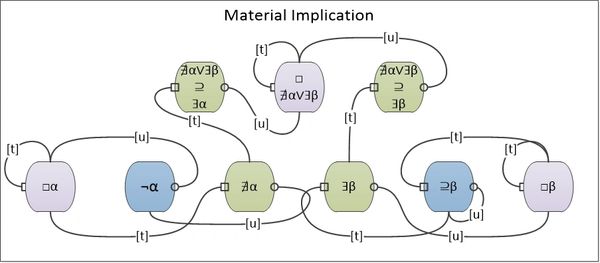Signed in as:
filler@godaddy.com
Signed in as:
filler@godaddy.com
A logical statement with a union or overlap copula and existential or non-existential quantification of its logical terms will form a logical connective.
A logical statement in which the modal occasion of the copula limits the quantified triadic occasions of two logical terms is a union.
A logical statement in which the modal occasion of the copula is limited by the quantified triadic occasions of two logical terms is an overlap.
Logical statements having only existentially or non-existentially quantified terms, that also have either union or overlap copulas correspond to the Boolean Logical Connectives in Pattern Logic.
When the two logical terms of a connective logical statement have the same quantification, it is called a junctive.
When the two logical terms of a connective logical statement do not have the same quantification, it is called an implicative.
The Pattern Syllogistic rules of elimination do not apply to logical connectives because the union and overlap forms of the general statement's copula is now symmetric, whereas it was asymmetric in the logical premises. As a result, there is no transitivity of pattern that can cross a connective statement from one of its terms to the other.
But a different collection of inferences emerges within the complex connective statements (a connective of connectives). These are called decisions and they can be split into two groupings called judgement and determination. Judgement involves the assignment of truth and determination involves the handling of redundancy.
While modern propositional logic will require a handling of truth-values and statements of equality, pattern logic firmly sets these in the expressive realm of complex connective statements. We need to first look at the realm of the simple junctives and implicatives as well as what it is that makes them interesting and useful: involution.
The expression of the simple connectives in pattern logic initially follows a predictable path for those familiar with modern logic but it will soon take an interesting turn.

ꓱα ∧ ꓱβ (α ∧ β)
The purple occasion at the top center of the diagram is rendered "alpha AND beta" and has necessary modality.
Non-Conjunction is the involution (opposite) of Conjunction.

∄α ∨ ∄β (α ↑ β)
The purple occasion at the top center of the diagram is rendered "NOT alpha AND beta" and has necessary modality.
Conjunction is the involution (opposite) of Non-Conjunction.

ꓱα ∨ ꓱβ (α ∨ β)
The purple occasion at the top center of the diagram is rendered "alpha OR beta" and has necessary modality.
Non-Disjunction is the involution (opposite) of Disjunction.

∄α ∧ ∄β (α ↓ β)
The purple occasion at the top center of the diagram is rendered "NOT alpha OR beta" and has necessary modality.
Disjunction is the involution (opposite) of Non-Disjunction.

∄α ∨ ꓱβ (α → β)
The purple occasion at the top center of the diagram is rendered "IF alpha THEN beta" and has necessary modality.
Non-Implication is the involution (opposite) of Material Implication.

ꓱα ∧ ∄β (α ↛ β)
The purple occasion at the top center of the diagram is rendered "alpha BUT NOT beta" and has necessary modality.
Material Implication is the involution (opposite) Non-Implication

ꓱα ∨ ∄β (α ← β)
The purple occasion at the top center of the diagram is rendered "IF beta THEN alpha" and has necessary modality.
Converse Non-Implication is the involution (opposite) of Converse Implication.

∄α ∧ ꓱβ (α ↚ β)
The purple occasion at the top center of the diagram is rendered "beta BUT NOT alpha" and has necessary modality.
Converse Implication is the involution (opposite) of Converse Non-Implication.
The astute student of logic will likely be scratching their head when they see "non-existential quantifiers" (∄) where a complement/negation sign (¬) is expected. What is going on here?
Pattern Logic understands the negation of a term not as a unary operator but rather, as a type of quantification specific to that term. This is based in the fact that a pattern transformation of involution applied to an existentially-quantified logical term results in a non-existentially-quantified term in Pattern Logic.
But this idea holds for more than just the involution of quantified terms. The entire pattern of a logical statement may also be involuted to determine its opposite or "logical complement". As mentioned in the descriptions of the simple connectives above, this produces all of the expected results so far (.ie the opposite of conjunction is non-conjunction). It is just as if one were to apply De Morgan's Laws or work it out with Venn Diagrams. They just have to treat each "∄" like a "¬".
But this is all about to change when we move to statements about statements and what it means to find their opposites.
The idea in pattern logic is a straight forward one: involution of patterns that follow the general form of a logical statement produces the "logical complement" of that statement. But the result is quite surprising!

Copyright © 2024 Pattern's Language - All Rights Reserved.
ADEPT LION is a Salveretec PBC patented invention